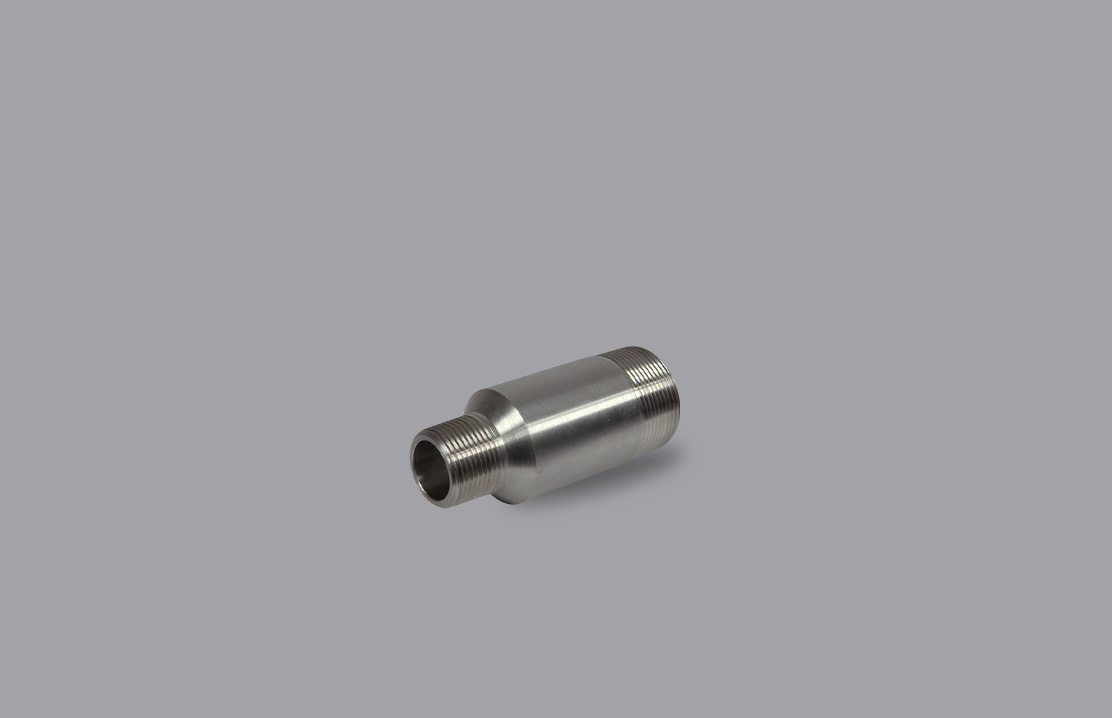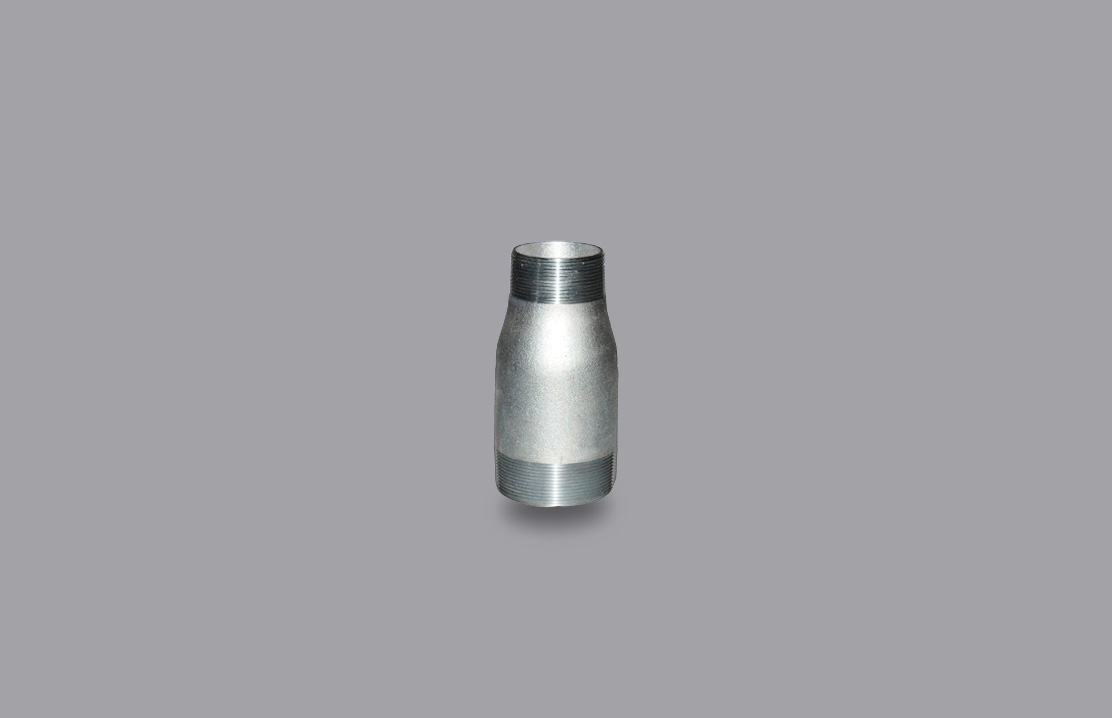Alloy Steel Swage Nipples (CONC. & ECC.)
Home - Alloy Steel - Alloy Steel Seamless Buttweld Fittings - Alloy Steel Swage Nipples (CONC. & ECC.)
Alloy Steel Swage Nipples (CONC. & ECC.)
EBY Fasteners, a leading supplier of piping components, offers top-quality Alloy Steel Swage Nipples. These versatile fittings connect butt-welded pipes with socket-welded or screwed pipes. Choose from concentric swage nipples, which maintain a uniform bore diameter for a seamless flow, or eccentric swage nipples that allow for alignment adjustments in less critical piping systems
Alloy steel swage nipples from EBY Fasteners boast impressive features. Their robust mechanical properties ensure efficient working strength, while corrosion resistance makes them suitable for challenging environments. Designed for longevity and available in a range of sizes from ½” to 6”, these nipples come in both seamless and welded options to meet the diverse requirements of your piping system


Whether you require the smooth flow and symmetry of concentric swage nipples or the alignment flexibility of eccentric swage nipples, EBY Fasteners delivers reliable alloy steel solutions for your piping needs


Whether you require the smooth flow and symmetry of concentric swage nipples or the alignment flexibility of eccentric swage nipples, EBY Fasteners delivers reliable alloy steel solutions for your piping needs
- WP 1, WP 5, WP 9 : Affordable and Adaptable These grades offer a cost-effective starting point for alloy steel swage nipples. They provide a balance of strength and moderate temperature resistance, making them suitable for various general-purpose piping systems where some corrosion resistance is needed.
- WP 11, WP 12, WP 22 : Stepping Up Performance With increased chromium and molybdenum content, these grades outperform the base WP grades in high-temperature environments and when corrosion becomes a greater concern. Think of them as the choice for power plant components, refineries, or chemical processing where conditions are more demanding.
- WP 91 : The High-Pressure Specialist This grade thrives in systems where both extreme temperatures and high pressures are present. It's designed for critical components where failure is not an option, ensuring structural integrity under the most challenging circumstances within its operational range
- Material Grades : The alloy steel used determines the nipple's strength, temperature resistance, and corrosion resistance. Choose from carbon steels, chromium-molybdenum steels, stainless steels, or low-temperature steels based on your needs.
- Manufacturing Standards : Standards like ASTM/ASME A/SA 234 and MSS-SP-95 ensure quality and compatibility.
- Dimensions : Consider the type (concentric or eccentric), nominal pipe size (NPS), schedule (wall thickness), and end connection type (threaded, socket weld, or butt weld).
- Performance Factors : Select a nipple that matches your system's working pressure, temperature range, and required corrosion resistance.
- Additional Considerations : Seamless construction offers higher pressure ratings, while welded allows for customization. Consider the desired surface finish and ensure any necessary certifications are met
- Material Properties : Alloy steels used in swage nipples provide strength for high-pressure loads and durability for long-term use. Chromium and molybdenum additions in certain grades offer high-temperature resistance for refineries and power plants. Stainless steel options enhance corrosion resistance, especially in harsh environments.
- Design & Construction :Choose between concentric nipples for seamless flow or eccentric nipples for alignment flexibility. Seamless construction generally handles higher pressures, while welded construction allows customization. Threaded, socket-weld, and butt-weld end connections ensure compatibility with various piping setups.
- Performance : Alloy steel swage nipples reliably handle a range of pressures and temperatures. Their robust composition contributes to a long service life, reducing downtime and costs in your piping system.
- Additional Considerations : These nipples offer a cost-effective solution compared to exotic materials while maintaining performance. Manufacturing according to ASTM/ASME standards guarantees quality and compatibility. Look for certifications that verify material properties and performance testing
- Refinery & Petrochemical : They are used in the transportation of oil, gas, and other chemicals under high pressure and temperature conditions.
- Chemical : In chemical processing plants, they are used to connect pipes of different diameters for the safe and efficient transport of chemicals.
- Oil & Gas : They are used in both upstream and downstream processes for the transportation of oil and gas.
- Power Plant : They are used in power plants for the transportation of steam and other fluids under high pressure.
- Offshore Platforms : They are used in offshore oil and gas platforms for the transportation of oil, gas, and water under extreme conditions.
- Ship Building : In shipbuilding, they are used in the construction of pipelines for fuel, water, and waste management systems.
- Industrial Machineries : They are used in various industrial machines for the transportation of fluids under high pressure.
- Pharmaceuticals : In the pharmaceutical industry, they are used in the production and processing lines for the transportation of various fluids.
- Pumps & Compressor : They are used in pumps and compressors for the efficient transportation of fluids.
- Dairy & Food : In the dairy and food industry, they are used in the processing lines for the transportation of milk, juices, and other fluids.
- Sugar Mills : They are used in sugar mills for the transportation of juice, water, and other fluids.
- Textile Machineries : In textile machinery, they are used for the transportation of dyes, water, and other chemicals.
- Fertilizers & Pesticides : They are used in the production lines of fertilizers and pesticides for the transportation of various chemicals
Chemical Composition
| Element | Percentage Range |
|---|---|
| C (Carbon) | 0.08% - 0.35% |
| Mn (Manganese) | 0.30% - 2.00% |
| P (Phosphorus) | Up to 0.045% (max) |
| S (Sulfur) | Up to 0.030% (max) |
| Si (Silicon) | 0.10% - 1.00% |
| Cr (Chromium) | 0.40% - 20.00% |
| Mo (Molybdenum) | 0.45% - 3.00% |
| V (Vanadium) | 0.18% - 0.25% |
| Nb (Niobium) | 0.06% - 0.10% |






